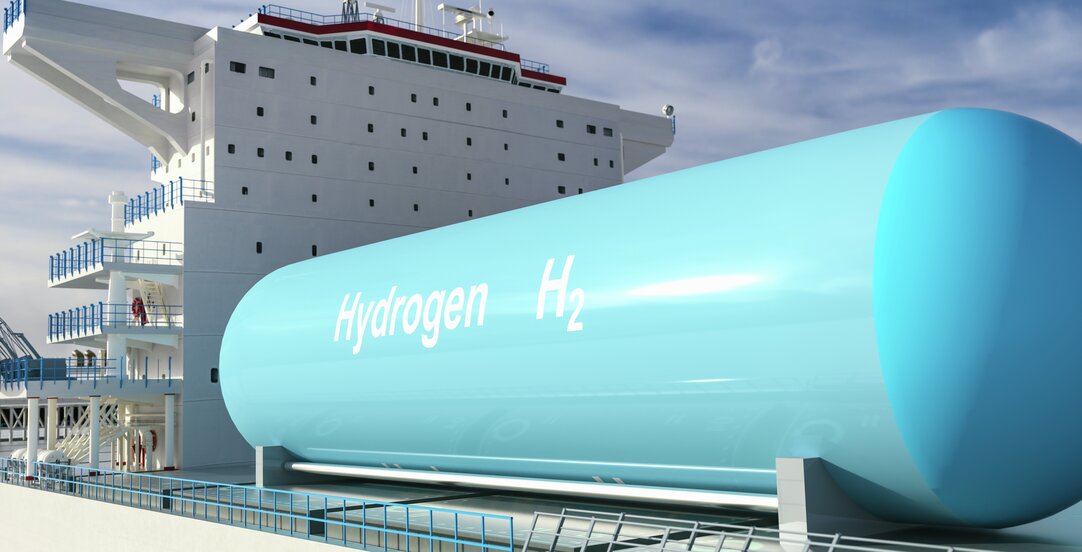Hydrogen as a maritime fuel and the shipping industry’s need for transition

In the coming decades, the shipping industry will have to make a transition to sustainable fuels and energy carriers. Hydrogen has been highlighted as one of the means to achieve this transition, and in Norway several interesting projects are currently ongoing.
Reading time 8 minutes
In this article, we will highlight some of the recent developments within hydrogen for the shipping industry. Further, and based on our hands-on experience with these types of projects, we will highlight some of the innovative and potentially game-changing projects which currently are ongoing as well as certain key legal elements for such development projects.
Shipping as a source for greenhouse gas emissions – IMO’s Fourth GHG Study
International shipping is essential for trade and vital for the global economy. However, it is also a source of greenhouse gas emissions. According to the Fourth IMO GHG Study, published by the International Maritime Organisation (“IMO”) earlier this year, emissions from international shipping amounted to over one billion tons of CO2 in 2018. This corresponds to almost 3 percent of the global greenhouse gas emissions. The study also shows that the amount of CO2 emissions from shipping increased by almost 10 percent in the period between 2012 and 2018, primarily due to an increase in global maritime trade. It is estimated that CO2 emissions from shipping will increase significantly towards 2050 if mitigation measures are not put in place.
An International approach is necessary – Recent developments at IMO and the EU
Since the shipping industry is global, it is generally recognised that a global approach is necessary when addressing greenhouse gas emissions. Many are therefore of the view that IMO’s role is essential. It was therefore welcomed by many in the industry, when IMO in 2018 adopted its climate strategy. In the strategy, IMO committed to ensure that the annual greenhouse gas emissions from international shipping are reduced by 50 percent by 2050 (compared to 2008 levels). Although viewed as ambitious by some, many are of the view the goals are too unambitious. Further, the strategy does not in itself implement any new measures for the shipping industry. Its key purpose is only to increase focus on greenhouse gas emissions, and to identify measures which may be implemented in the shipping sector in order to achieve the overall goal of reducing greenhouse gas emissions. The specific measures are up to the industry to develop and implement.
Although IMO has identified some specific measures to address greenhouse gas emissions, including further requirements to the energy efficiency measures in the International Convention for the Prevention of Pollution from Ships (“MARPOL”), few specific measures have been adopted as requirements as of today. Many therefore criticise IMO’s work for progressing too slowly. This has recently triggered the European Union to take action. In September 2020, the European Commission presented its 2030 Climate Target Plan, which is part of the European Green Deal, aiming to cut greenhouse gas emissions by at least 55 percent, compared to 1990 levels, by 2030, and to put the EU on a path to becoming climate neutral by 2050.
The European Green Deal and the 2020 Climate Target Plan has since been followed up with specific policy proposals in the “Fit for 55-package” presented by the European Commission July this year. The policies proposed includes the FuelEU Maritime regulation, and the implementation of the EU Emissions Trading System (ETS) for the shipping sector. These policies aim to foster the market uptake of sustainable fuels within the shipping sector. Before being adopted, the proposals will be discussed and negotiated within the European Council and the European Parliament. If adopted by the EU, they will likely also be relevant for Norway and implemented in Norway through the EEA Agreement.
The importance of sustainable fuels in the transition in the shipping sector
The recent developments underline the need for decarbonisation and transition within the shipping sector. To a certain extent, greenhouse gas emissions can be reduced through energy-saving technologies and speed reduction of ships. However, in the Fourth IMO GHG Study it is concluded that a significant amount of the CO2 reduction will have to come from the use of alternative sustainable fuels and energy carriers in order to achieve the commitments in IMO’s own GHG Strategy from 2018. The pressure is therefore on the industry to ensure that the transition is made a reality. This pressure will likely increase in the next few years, as it is likely that additional rules and regulations will be proposed and adopted.
Currently, a wide range of different alternative low and zero-emission fuels and energy carriers are being considered and developed within the shipping sector. This includes liquefied petroleum gas, methanol, ethanol, dimethyl ether, biofuels, synthetic fuels, electricity/batteries, hydrogen, ammonia and nuclear propulsion. However, while there are significant developments, few vessels today are operating solely on sustainable fuels or energy carriers. This is partly due to the fact that the fuel and energy carriers must be adapted and optimised to suit the energy needs and operating profiles of each vessel. Different solutions will therefore likely be necessary for different types of vessels. Lack of maturity, as well as costs (and therefore need for further technology optimisation) and availability of fuels, are also factors which the industry have to take into account.
In the European Union and Norway, hydrogen and hydrogen-based energy carriers, such as ammonia, have in recent years been given particular attention. In Norway, hydrogen was highlighted as a potential zero emission energy carrier within certain sectors of the shipping industry in the Norwegian Government’s “Hydrogen Strategy” from June 2020. In the Norwegian Government’s “Roadmap for Hydrogen”, published July 2021, it is also stated that Norway’s vision is to have a well-established market for production and use of hydrogen within the shipping sector in 2050, and that hydrogen at this point in time should be used on vessels both in coastal waters and for long-distance transport.
In order to reach the vision for increased production and use of hydrogen, the Norwegian Government has stated that it will act as a facilitator and support the industry, including by creating hydrogen hubs for maritime transport within 2025, by giving support to industrial projects related production of hydrogen, as well as pilot projects for development and demonstration of new and more cost-efficient hydrogen solutions and technologies. Within 2030, the overall goal is that hydrogen vessels are competitive and safe alternatives within shipping in Norwegian seas and short sea shipping, and that hydrogen is a competitive alternative to fossil fuels.
The UK equivalent to the “Roadmap for Hydrogen” is the UK’s “Hydrogen Strategy”, which was released in August 2021, following from the UK’s “Ten Point Plan for a Green Industrial Revolution, 2020”. The UK’s ambition is to have 5GW of low carbon hydrogen production capacity by 2030. Significant funding packages and consultations are being put in place to support this target. Short term plans must give due consideration to existing infrastructure and regulatory landscape, but the UK Government also intends to review legal and practical measures that may support more ambitious developments in the future. Similarly to Norway, one of the UK’s initial focus points is on hydrogen-derived fuels such as ammonia, including as a shipping fuel.
Key hydrogen projects
The hydrogen strategies build on already existing projects in Norway and the UK. In the UK, BP recently presented its plans for construction of a major blue hydrogen production facility in Teesside, which will produce up to 1GW of blue hydrogen by 2030, equal to 20 percent of the UK’s hydrogen target. In Norway, the world’s first ferry to use liquid hydrogen as an energy carrier, MF Hydra, was delivered earlier this year. There are also several ongoing research and development projects. For example, a consortium was established in 2019 in order to demonstrate that long-range zero-emission voyages with high power on larger ships is possible (ShipFC). This will be done by retrofitting an offshore vessel, Viking Lady, which is operated by Eidesvik Offshore, with ammonia fuel cells. The project is currently well underway, and has received substantial public funding both in Norway and from the EU’s Fuel Cells and Hydrogen 2 Joint Undertaking.
Another interesting project, is the consortium established in order to build a complete maritime value chain for liquid hydrogen on the western coast in Norway. This consortium was established in 2020 by nine different companies operating on different levels of the maritime value chain. The project includes construction of a new production facility for liquid hydrogen at Mongstad, construction of new ro-ro vessels which will use liquid hydrogen as its energy carrier, and development of infrastructure, hereunder for bunkering and distribution of liquid hydrogen. The value chain will be the first of its kind in the world (subject completion). Currently, the project is well underway, and has received funding from Innovation Norway, the Norwegian Research Council and Enova.
Our experiences so far
Wikborg Rein has been and is currently involved in several projects related to hydrogen and the industry’s transition to sustainable fuels and energy carriers. We have in this respect assisted client’s in all phases in different projects. In these types of project, many different considerations are necessary at different stages. In the initial phase, with letters of intent and establishment of consortiums, it is our view that it is crucial to have a good understanding of the totality of the project and each party’s role, in order to ensure that the involved entities are given an efficient basis for their collaboration and prepare a foundation from the start that takes all (factual and legal) aspects into account. It is by way of example imperative to have knowledge of the incentive schemes, and to carefully consider and develop tailored rules regarding ownership to intellectual property rights and other projects results, in order to lay the foundations for, and facilitate, future commercialisation.
If a project is to be commercialised, a wide range of different areas of law will be relevant. The involved companies for example need to agree on how to commercialise the project. In this respect, many different models are possible. The partners may agree that one of them should commercialise the project alone, with or without an obligation to pay royalties to the others involved. Alternatively, the partners may agree to commercialise the project jointly by establishing a new jointly owned entity. If a new entity is to be established, legal advice on several aspects will likely be necessary, including company law, competition law, tax law, construction and contract law, employment law and state aid.
Hydrogen plays a key role in the transition to sustainable fuels and energy carriers
The above illustrates that the shipping industry’s transition to sustainable fuels and energy carries is already well underway. Furthermore, although hydrogen may not be the only answer to this transition, it has lately been given particular attention both in Norway and in the European Union. The future developments should be followed closely by those involved in the industry.
